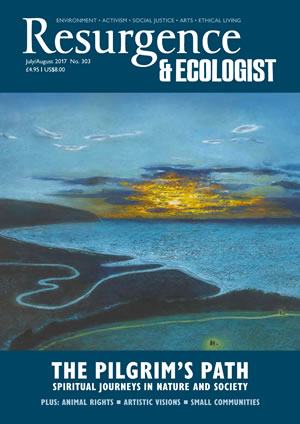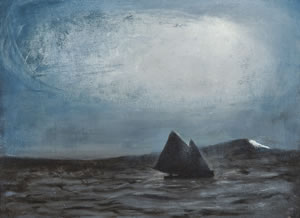“To be a pilgrim is to be connected”– Satish Kumar
For two days and two nights I waited for the north-westerly gale to blow through. Fierce squalls came gusting down through the mountains, and with them a rattling of heavy rain across the deck. I was on my little yacht Coral, moored to a visitors’ buoy at Craighouse on Jura in the Western Isles of Scotland. This was the final stage of my ecological pilgrimage round the west coast of Ireland to Scotland, sailing mostly on my own. The weather had been particularly difficult. I was weary, and keen to get to Coral’s winter berth near Oban.
Eventually the gale blew through. Overnight, the wind dropped away to nothing. In the grey dimness just before dawn I dropped the lines on the mooring buoy and steered Coral out of the bay. The green and red navigation lights that mark the channel between Goat Island and the underwater reefs flashed reassuringly. Once clear of the island, I turned Coral north up the Sound of Jura, intent on catching the last of the flooding tide north toward Oban.
When the tide turned against me, I took Coral into Lussa Bay, tiny, south-facing, 12 miles or so north from Craighouse, and tucked her in behind a rocky peninsula out of the stream. A lone cormorant stood sentinel on the tip of the rocks. Low cloud enveloped the hilltops, and mist descended to sea level, full of dampness that now and again turned into light rain. The ensign hung soggily from the backstay. Through the mist the tones of the land were subdued: a sharp green scrub, russet-brown bracken, punctuated by the black silhouettes of windblown trees; rocks dark and wet at the waterline, lighter above. In contrast to this wildness, at the head of the bay I could just see a little pocket of cultivation: a house showing white amid a cluster of mature trees; a bridge over a stream; a meadow where a brown horse was grazing.
Once I was sure the anchor was secure, I cut the engine. Its mechanical grumble and the churn of the propeller had filled my ears for two hours. Once it stopped, I felt the silence as a tangible presence inviting me to open to my surroundings. Gradually my ears cleared of engine noise and I could hear the subtle watery sounds around me: the background burbling of the tidal stream out in the sound; the deeper, hollow percussion of wavelets slopping against the rocks; the occasional creaks from the engine as it cooled down; above all these the faint patter of fine rain on the deck and spray hood that came and went as showers blew through the bay, punctuated by the thud of larger drops falling from the boom.
As I stood in the companionway out of the rain, looking across the bay, I heard a guttural call. I looked around and saw a raven flapping its wings to land among the rocks, the inky black of its feathers penetrating the rain mist and standing out strongly against the grey of the rocky shore. I watched as it searched the foreshore. Then another movement caught my eye, across the water this time: an otter, maybe, but more likely a seal. I searched the surface hopefully, but saw no further sign.
I came here for the purely practical purpose of waiting out the adverse tide. But the bay seduced me: I became enchanted. I spent hours watching, listening, scribbling incoherent notes as I searched for the right words. The quiet of this bay silenced my mind. I was absorbed with just being there.
By mid-afternoon the ebb had weakened. It was time to get going again so as to reach the tidal race at the Sound of Luing at slack tide. I started the engine, hauled up and stowed the anchor, edged Coral round the low rocky headland that had sheltered us, and continued northwards.
There is a longstanding tradition in most human societies of making a more or less arduous journey away from the comforts and familiarities of home in search of new insights and deeper understandings. This practice may be as old as the human species: Mesolithic peoples in Europe certainly made long journeys to the sacred sites marked by stone circles; the Aboriginal people of Australia still take extended walks along songlines, re-enacting the journeys of ‘creator-beings’ during the Dreamtime.
The idea and practice of pilgrimage was systematically forged in a religious context: I think of the requirement for good Muslims to undertake the Hajj at least once in their lives; the Christian pilgrimages of the Middle Ages and the continuing contemporary practice; the vast numbers of Hindu devotees who travel to sacred sites on the river Ganges; the Buddhists who walk the difficult path to circumambulate Mount Kailash.
The English term ‘pilgrim’ originally comes from the Latin word peregrinus (from per, meaning ‘through’, plus ager, meaning ‘field’, ‘country’, ‘land’), which means a foreigner, a stranger, someone on a journey, or a temporary resident. It can describe a traveller making a brief journey to a particular place, or someone settling for a short or long period in a foreign land. Peregrinatio was the state of being or living abroad; and of course all Christians were seen as temporary residents in this world, “strangers and pilgrims on the Earth”, travelling towards “a heavenly country”. Here on Earth, wrote St Augustine, Christians wander “as on pilgrimage through time looking for the Kingdom of eternity”.
This contrasts with an ecological view that we are indigenous Earthlings first: we are not just passing through; we evolved with and profoundly belong to this planet. Our place is not in heaven, but here. As Aldo Leopold, one of the originators of the modern ecological movement, wrote in A Sand County Almanac, we are plain members of the biotic community.
So how might we think of an ecological pilgrimage? The faithful travel to sacred sites in order to encounter a holy realm for worship and the affirmation of faith, in search of illumination and for healing. I think of the ecological pilgrimage as a search for a primal, heartfelt connection with the Earth and her community of beings. It is also an ongoing celebration of that connection and an act of homage, honouring the Earth as the more-than-human world of which we are a part, present for itself rather than for human use.
Pilgrims separate themselves from home and familiars, and may join with a group of like-minded seekers, sometimes wearing special clothes or other marks that indicate their pilgrim status. In an important sense the pilgrim leaves the everyday and familiar, and journeys through an in-between space towards some transcendent purpose. By taking the pilgrim away from the habits of civilisation and by disrupting the patterns of everyday life, pilgrimage opens an imaginative space, presenting a different view of the Earth of which we are a part.
The ecological pilgrim journeys into the wild, whether the distant wild of the seas or mountains or the more immediate wild of a meadow flower. The wild in this sense can release us from the constraints of everyday consciousness. The ecological pilgrim starts from a sense of the importance and legitimacy of unmediated, direct experience of the more-than-human, independent of any benefits that might arise out of that experience. The poet and wilderness writer Gary Snyder describes the wilderness pilgrim’s ‘step-by-step, breath-by-breath’ progress into the wild, whether the wild of mountains or ocean or meditation, as an ancient set of gestures that bring a profound sense of joy. It’s a joy that arises through intimate contact with the real world and so also with oneself.
This is why pilgrimages into the wild world are one response to the ecological crisis of our times. They are not, of course, a sufficient response, for we also urgently need a whole range of political, financial, technological and cultural initiatives that would change society as we know it. I think they are nevertheless a necessary response that may inform these practical and political concerns. Opening yourself to the wild world and describing what you find with love and passion is a political and spiritual act.
The Christian writer Martin Palmer tells us that to undertake a pilgrimage is to place yourself at risk: not just the physical risk, but also the risk that you may not return the same person as you set out. He also warns that the pilgrim may even risk being surprised by joy. Alone at sea I was often disoriented from the taken-for-granted realities of the social world and open to a more naked sense of what it is to be a human being. At such moments it was as if a crack in the cosmic egg opened and for a moment I experienced a different world that is nevertheless the same world. This was a world not fixed in form, but forever changing: no longer divided into separate things, but one dancing whole. I realise that these moments occur in everyday life, but they are easy to overlook, to see as insignificant.
I have come to call these experiences “moments of grace”: they arose in the terror of tumultuous seas as much as in the wonder of the night sky; they arose unbidden and unexpected, as in my enchantment with Lussa Bay. They are a recovery of the sacred dimension of being in the world.
This article is adapted from his book In Search of Grace: An Ecological Pilgrimage, published at the end of 2017 by Earth Books.








